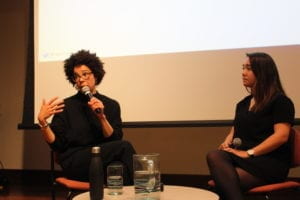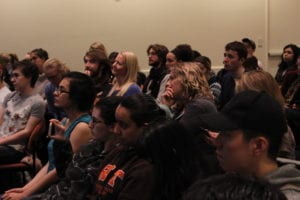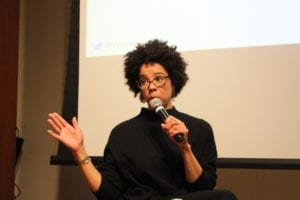
On April 2nd, 120 students, faculty and curious New Yorkers alike filled into Kimmel to hear Educating for Sustainability’s 2018 speaker, Dr. Ayana Johnson. I wrote a Women’s (Green) History Month spotlight about Dr. Johnson, so I already knew she was an impressive individual, but her talk kind of blew my mind.
Many of the people in the audience were interested in topics of sustainability and ocean conservation, but we all had something to learn from Dr. Johnson’s pioneering work.
As executive director of the Waitt Institute, Dr. Johnson co-founded the Blue Halo Initiative with the goal of working with island governments and local communities to create meaningful zoning ocean laws to improve coastal livelihood. Dr. Johnson worked for years to implement the Caribbean’s first successful island-wide ocean zoning effort. At the talk, Dr. Johnson took us through the complicated steps and many tireless nights to accomplish this feat.

As a cultural anthropologist student, it warmed my heart when Dr. Johnson emphasized the importance of cooperation between scientists, government employees as well as the true-and-tried experts, the local population. Dr. Johnson admitted she baked goodies and interrupted a game of dominoes in order to talk to the local fishermen to understand how they fish in order to create the best plan.
Without giving away their secret fishing spots, Dr. Johnson ascertained the fishing “hot” spots as well as areas where fisherman saw habitat degradation. She told us how vital the wildlife is to locals, one fisherman she went out on the water with teared up at the loss of a once vibrant coral reef.
These are heart wrenching tales told beautifully through the eyes of a researcher. Many people in the public think of scientists as numbers-oriented and detached, but Dr. Johnson’s success with the Barbuda’s zoning policy shows that the scientific community relies on the local community to inform us how our chalkboard policies would actually affect everyday life.

Dr. Johnson also talked about the thriving coastal life in an urban context, particularly, the islands that constitute New York City. Initiatives like the Billion Oyster Project seek to empower everyone from New York high schools and middle schools to local restaurants to take back their coast. Their ambitious goal is to restore the oyster population to 1 billion by 2030.
Following Dr. Johnson’s talk, her student and Office of Sustainability EcoReps Coordinator Rae Frey led a moderated Q&A session. I personally loved when Rae asked Dr. Johnson if she still ate seafood. Dr. Johnson responded that she might go on a rant about the horrors of the shrimp industry and added you might not want to take her out to eat sushi.
Yet, the Q&A also brought up points I’m sure all students have asked. Why do many environmental non-profits only offer unpaid internships? Dr. Johnson thinks this impedes young professionals of color from getting their foot in the door and only hurts the industry in the long run. Her solution is to invest in the next generation’s leaders through fellowships and paid internships.
Dr. Johnson gave me hope that the future in environmental science, especially ocean conservation, is going to look a lot more diverse and focused on including the people climate change affects the most.
